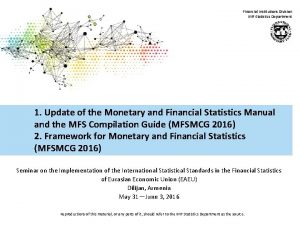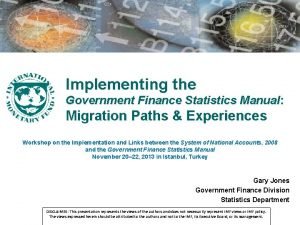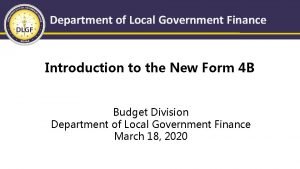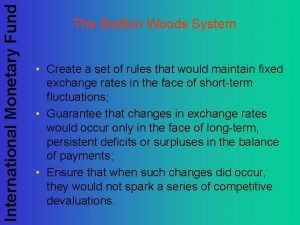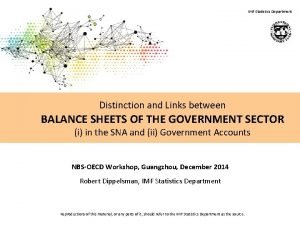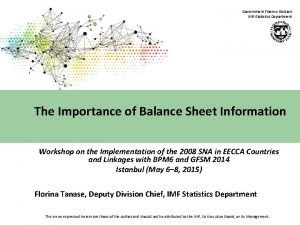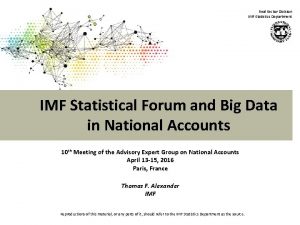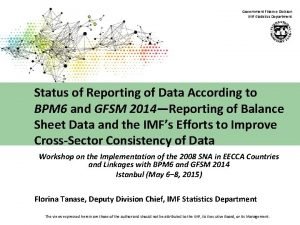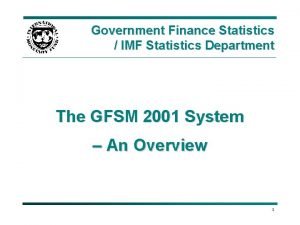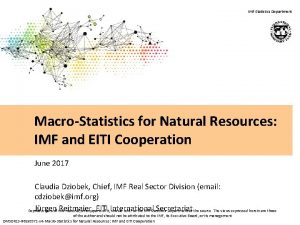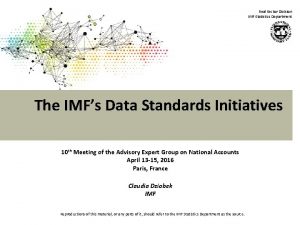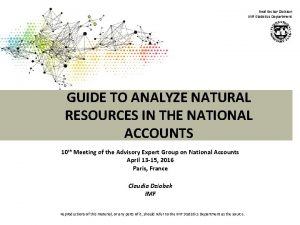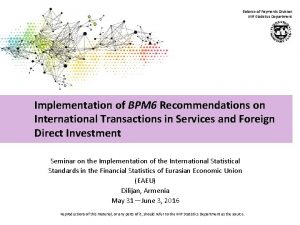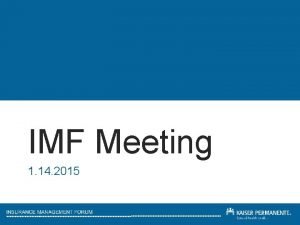Government Finance Division IMF Statistics Department The Importance




















- Slides: 20

Government Finance Division IMF Statistics Department The Importance of Balance Sheet Information Workshop on the Implementation of the 2008 SNA in EECCA Countries and Linkages with BPM 6 and GFSM 2014 Istanbul (May 6– 8, 2015) Florina Tanase, Deputy Division Chief, IMF Statistics Department The views expressed herein are those of the author and should not be attributed to the IMF, its Executive Board, or its Management.

Government Finance Division IMF Statistics Department Overview § Why Balance Sheets Matter? § Balance Sheet Analysis in IMF Surveillance § Data Sources and Data Gaps for the Balance Sheet Analysis § Looking Forward 2

Government Finance Division IMF Statistics Department Why Balance Sheets Matter? “National balance sheet analysis, examining vulnerabilities in all sectors individually and in aggregate, could have made a difference to preventing the global financial crisis. “ Sir Paul Tucker, Former BOE Deputy Governor, from the 2014 Triennial Surveillance Review (TSR) External Study on Risks and Spillovers. 3

Government Finance Division IMF Statistics Department Balance Sheet Analysis in IMF Surveillance (1/10) § Economic and financial surveillance: one of the most important roles of the IMF; it focuses on identifying risks and policies to mitigate them § Keeping surveillance relevant: triennial surveillance reviews (TSRs) with the most recent completed in September 2014 § 2014 TSR priorities: • Deepen analysis of risks and spillovers • Increase attention to national balance sheets and cross-border positions • Further develop the balance sheet approach (BSA) based on granular national and external balance sheets 4

Government Finance Division IMF Statistics Department Balance Sheet Analysis in IMF Surveillance (2/10) § Key recommendation of the 2014 TSR: strengthen analysis of national balance sheets “The Fund has overhauled its surveillance to make it more risk based and better reflect global interconnections… The goal now is to take this work to the next level, by focusing more on how risks spread across countries and how, in turn, spillovers can transmit across sectors. ” 5

Government Finance Division IMF Statistics Department Balance Sheet Analysis in IMF Surveillance (3/10) Why develop balance sheet analysis? § TSR proposes expanding balance sheet analysis in surveillance for: • • • Indicators of balance sheet vulnerability (i. e. , FX mismatches) Scenario analysis tracing transmission of shocks across sectors Assess consistency of growth outlook and balance sheet condition § Exploit data improvements using BSA matrix as surveillance tool • Start with basic sector disaggregation possible with IMF data and expand § Allows analysis of linkages across sectors, not just one sector at a time 6

Government Finance Division IMF Statistics Department Balance Sheet Analysis in IMF Surveillance (4/10) § The IMF use of balance sheets in surveillance evolved over time: • • • Pre-Asian crisis: balance sheets with focus on public and external debt Asian crisis led to development of the balance sheet matrix covering entire economy—balance sheet approach (BSA) Global crisis highlighted gaps in balance sheet analysis related to (i) increased financial complexity and (ii) inadequate surveillance of cross-border links between balance sheets § Focus of the BSA: • Stocks of assets and liabilities • System of interlinked sectoral balance sheets 7

(Example 1: FX shock-corporates borrow in FX) Government Finance Division IMF Statistics Department Holder of the Liability (Creditor Sector) Government A L Financial Sector (incl. Central Bank) A L Other Non. Financial Sectors A L External A TOTAL L A Government In domestic currency ST LT In foreign currency Issuer of the Liability (Debtor Sector) ST LT Financial Sector (incl. Central Bank) In domestic currency ST LT ing In foreign currency ST d ce d len du Re LT Other Non. Financial Sectors In domestic currency Increase in NPLs ST LT In foreign currency ST Co rpo rat LT External eb ank rup tcy In domestic currency ST LT In foreign currency ST LT Depreciation of the domestic currency TOTAL In domestic currency The views expressed herein are those of the author and should not be attributed to the IMF, its Executive Board, or its Management. In foreign currency L

(Example 2: liquidity shock) Government Finance Division IMF Statistics Department Holder of the Liability (Creditor Sector) Government A L Financial Sector (incl. Central Bank) A Other Non. Financial Sectors L A L External A TOTAL L A Government In domestic currency ST LT In foreign currency ST Issuer of the Liability (Debtor Sector) LT Financial Sector (incl. Central Bank) In domestic currency ST LT In foreign currency LT ST LT In foreign currency ST LT External In domestic currency ST LT In foreign currency ST e uc d Re Other Non. Financial Sectors In domestic currency g din en dl ST Rise in NPLs losses on assets De fau lt o nl oa Fi As re S se al ts e o f Unable to rollover external debt ns an db on ds Loss of liquidity LT TOTAL In domestic currency The views expressed herein are those of the author and should not be attributed to the IMF, its Executive Board, or its Management. In foreign currency L

(Example 3: contingent liabilities materialize)Government Finance Division IMF Statistics Department Holder of the Liability (Creditor Sector) Government A L Financial Sector (incl. Central Bank) A L Other Non. Financial Sectors A L External A TOTAL L A L Government In domestic currency ST LT Banks' exposure to sovereign In foreign currency Issuer of the Liability (Debtor Sector) ST LT Financial Sector (incl. Central Bank) In domestic currency ST LT Rise in interest rates Feedback loop to government In foreign currency ST LT Rise in debt from contingent liability Other Non. Financial Sectors In domestic currency ST LT In foreign currency Reduced lending ST LT External In domestic currency ST LT In foreign currency ST LT TOTAL In domestic currency In foreign currency. The views expressed herein are those of the author and should not be attributed to the IMF, its Executive Board, or its Management.

Government Finance Division IMF Statistics Department Balance Sheet Analysis in IMF Surveillance (8/10) § BSA allows analysis of key risks, as it generates indicators of • Currency mismatches • Maturity mismatches and liquidity risks • Capital structure mismatches (leverage) • Solvency or credit risks § Bilateral linkages between sectors in the BSA illustrate how shocks might propagate across sectors, including the potential for feedback effects that may magnify their initial impact 11

Government Finance Division IMF Statistics Department Balance Sheet Analysis in IMF Surveillance (9/10) 12

Balance Sheet Matrix (Expanded) Government Finance Division IMF Statistics Department d Holder of the Liability (Creditor Sector) Government Total In domestic currency Issuer of the Liability (Debtor Sector) In foreign currency Central Bank Total In domestic currency In foreign currency Banks (ODC) Total In domestic currency In foreign currency Other Financial Corp. (OFC) Total In domestic currency In foreign currency Non Financial Sector (Corp. + HH) Total In domestic currency In foreign currency External Total In domestic currency In foreign currency Government Central Bank A A L L Other Financial Corporation (OFC) Banks (ODC) A L Non Financial Sector (Corp. + HH) A L External A L

Government Finance Division IMF Statistics Department Data Sources and Data Gaps for Balance Sheet Analysis (1/5) A BSA matrix can be filled (much but not all) with data from various IMF datasets: § Standardized Report Forms (SRFs) § External sector statistics • International Investment Position (IIP) • Quarterly external debt statistics (QEDS) • Coordinated Portfolio Investment Survey (CPIS) • Coordinated Direct Investment Survey (CDIS) § Government finance statistics (GFS) § Public Sector Debt Statistics (PSDS) 14

SRF - Based Government Finance Division IMF Statistics Department Country Example IIP-Based GFS-Based BS Identity Holder of the Liability (Creditor Sector) Government A L Banks (ODC) Central Bank A L A Financial Sector (OFC) A L L Non Financial Sector (Corp. + HH) A L TOTAL External A L Government Total 351 0 In domestic currency In foreign currency 52 30 22 262 243 19 188 183 5 0 0 0 417 1, 370 1, 124 0 0 0 2 0 2 6 6 0 253 231 22 175 141 34 2, 881 2, 427 454 2, 733 2, 300 434 7 2, 154 1, 617 Issuer of the Liability (Debtor Sector) Central Bank Total In domestic currency In foreign currency 52 30 22 351 0 763 685 78 3 3 0 67 1, 155 0 33 0 1, 092 884 716 135 1, 516 361 1, 092 3, 809 2, 887 646 4, 049 3, 371 680 Banks (ODC) Total In domestic currency In foreign currency 188 183 5 262 243 19 3 3 0 763 685 78 0 0 0 0 0 175 141 34 253 231 22 2 0 2 2, 733 2, 300 434 2, 881 2, 427 454 299 241 58 44 44 0 484 43 166 115 3 115 Non-Bank Financial (OFC) Total In domestic currency In foreign currency 0 0 0 44 44 0 299 241 58 17 70 0 5 219 202 104 552 472 85 Non Financial Sector (Corporate + Household) Total 417 1, 370 In domestic currency In foreign currency 6 6 0 1, 703 383 3, 728 6, 112 1, 660 3, 377 External Total 915 In domestic currency In foreign currency TOTAL In domestic currency In foreign currency 1, 617 2, 154 1, 092 33 118 209 5 87 0 0 3 42 0 17 1, 092 33 115 166 5 70 1, 453 851 4, 051 3, 533 557 306 361 716 3, 371 2, 887 472 202 1, 092 135 680 646 85 104 383 1, 703 3, 728 6, 112 3, 377 1, 660

Government Finance Division IMF Statistics Department Data Sources and Data Gaps for Balance Sheet Analysis (3/5) Progress has been made through various initiatives: § Data Gaps Initiative with focus on priority areas identified by the crisis for G-20 • • • Global Systemically Important Financial Institutions International banking statistics, securities statistics, IIP, CPIS Sectoral balance sheets § SDDS Plus • Includes all data sets relevant for sectoral balance sheets § IMF/STA technical assistance/training/outreach 16

Government Finance Division IMF Statistics Department Data Sources and Data Gaps for Balance Sheet Analysis (4/5) § Around thirty countries report all needed data • Biggest gap: data on nonbank financial institutions (OFCs) § The BSA matrix is still useful for surveillance when data are incomplete • • In some emerging markets and low income countries, OFC balance sheets are small and can be ignored Gaps need to be identified and filled from national sources 17

Government Finance Division IMF Statistics Department Data Sources and Data Gaps for Balance Sheet Analysis (5/5) Main data gaps for balance sheet analysis: § Coverage • Nonbank financial institutions • Corporate sector • Household sector • Off-balance sheet data § Granularity • Breakdown by major currencies • Breakdown by remaining maturity • Bilateral counterpart information 18

Government Finance Division IMF Statistics Department Looking Forward (1/2) § Comprehensive reporting of data on IMF report forms is a key • Euro area collects but does not report OFC data as systems are being adapted § Identify data gaps from policy needs with priorities being based on capacity of countries 19

Government Finance Division IMF Statistics Department Looking Forward (2/2) § Augment BSA to analyze linkages within each sector (e. g. , within financial sector—analyze links between banks and nonbanking financial institutions) § Construct Global Flow-of-Funds (GFF) analysis to show spillover channels between national balance sheets • • additional data are needed to construct of full GFF matrix a partial GFF matrix is also useful to analyze financial spillovers (e. g. , IIP, international banking statistics, and CPIS data give cross country bilateral financial linkages) 20
 Imf financial statistics
Imf financial statistics Imf
Imf Migration
Migration Department of local government finance
Department of local government finance Financial econometrics
Financial econometrics Roles of imf
Roles of imf Imf adalah
Imf adalah Concept of imfa
Concept of imfa Difference between imf and world bank
Difference between imf and world bank Imf adalah
Imf adalah Imf functions
Imf functions India imf loan history
India imf loan history Imf practice
Imf practice Wto objectives
Wto objectives Imf chemistry
Imf chemistry Imf system
Imf system Debt imf
Debt imf Lambang imf
Lambang imf Imf chemistry
Imf chemistry Imf
Imf Department vs division
Department vs division

